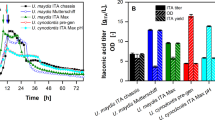Abstract
Shikimic acid has wide use in pharmaceuticals due to its application in the synthesis of drug Tamiflu used in the treatment of Swine flu. The high cost and limited availability of shikimic acid isolated from plants has impeded the use of this valuable building block of the drug. In this context, fermentation route to produce shikimic acid from renewable resources has become increasingly attractive. The present study was embarked upon isolation of wild-type microorganisms able to produce shikimic acid. Out of the 42 isolates obtained from the soil, isolate GR-21 was selected as the best with initial production of 0.54 g/L shikimic acid and later identified as Citrobacter sp. The process optimization resulted in 14-fold increase in the shikimic acid production, thereby claiming this process to be a sustainable alternative for the production of this important biomolecule. The process was further scaled up to 14 L bioreactor to validate the production of shikimic acid. Further, the product formed is shikimic acid was confirmed by FTIR analysis. The current studies suggest that the selected isolate could be used as a promising agent to fulfill the worldwide demand of shikimic acid.





Similar content being viewed by others
References
Elbehri, A. (2005). Biopharming and the food system: Examining the potential benefits and risks, AgBioForum. Available from: www.agbioforum.org.
Roche. (2006). Factsheet TamifluUS. Available from: www.roche.com/med_mbdtamifluo5e.pdf. Accessed 17 November 2006.
Bochkove, D. V., Sysolyatin, S. V., Kalashnikov, A. I., & Surmachena, I. A. (2011). Journal of Chemical Biology, 5, 5–17.
Guglielmini, G. (2011). Shikimic acid: an innovative ingredient for mulitiple cosmetic uses. Available from: www.specchemonline.com/articles/view/an-ingredient-for-multiple-cosmetic-uses. Accessed 21 November 2011.
Koshy, J. P., & Joseph, L. (2009). India steps up search for rare ingredient of swine flu drug India. Available from: www.livemint.com/2009/05/11234512/India-steps-up-search-forrare.html. Accessed 11 May 2009.
Novikova, A. E., Yampolskaya, T. A., Turchin, K. F., Anisimova, O. S., & Gusyatiner, M. M. (2006). The identification of dehydroshikimic acid accumulated in fernetation broth. The use of capillary electrophoresis for determeination of dehydroshikimic acid in enzymatic reaction mixtures for measuring activity of dehydroshikimic acid. In I. A. Krylov & G. E. Zaikov (Eds.), Industrial application of biotechnology. New York: Nova Science.
Frost, J.W., Frost, K. M., & Knop, D. R. (2002). Biocatalytic synthesis of shikimic acid. US patent application no. 6472 169 B1, 29 Oct 2002.
Shirai. (2001). Microorganism belonging to the genus Citrobacter and process for producing shikimic acid. Europian patent application no.1092 766, 18 Apr 2001.
Isar, J., Agarwal, L., Saran, S., & Saxena, R. K. (2006). Journal Anaerobe, 12, 231–237.
Johansson, M. Analysis and modelling of shikimic acid metabolism in Escherichia coli. Available from: www.chemeng.lth.se/exjobb/013.pdf. Accessed 25 Sept 2010.
Sui, R. (2008). Journal of Chemical Engineering Technology, 31(3), 469–473.
Caprette, D. R. (2011). Laboratory studies in applied microbiology, Available from: www.ruf.rice.edu. Accessed 25 December 2011.
Buchanan, R. E., & Gibbons, N. E. (1974). Bergey’s Manual of Determinative Bacteriology (8th ed.). Baltimore: Williams & Wilkins Co.
Gong, S. J., Lu, Z. M., Shi, J. S., Dou, W. F., Xu, H. Y., Zhou, Z. M., et al. (2011). Journal of Applied Biochemistry Biotechnology, 165, 963–977.
Johansson, L., & Liden, G. (2006). Journal of Biotechnology, 126, 528–545.
Kobayashi, M., Nagasawa, T., & Yamada, H. (1992). Trends in Biotechnology, 10(11), 402–408.
Escalante, A., Calderon, R., Valdivia, R., Anda, R. D., Hernandez, G., Ramirez, O. T., et al. (2010). Microbial Cell Factories, 9, 21.
Rangachari, S., Friedman, T. C., Hartmann, G., Hemminghaus, J. W., Kretzmer, K. A. Nissing, N. J. (2010). Processes for producing and recovering shikimic acid. US patent application no. 2010/0298599 A1, 25 Nov2010.
Chandran, S. S., Yi, J., Von Draths, K. M., Daeniken, R., Weber, W., & Frost, J. W. (2003). Biotechnology Progress, 19(3), 808–814.
Abusham, R. A., Rahman, R. N., Salleh, A. B., & Basri, M. (2009). Microbial Cell Factories, 9, 8–20.
Oh, A. J., Lee, H. W., Saha, R., Park, M. S., Jung, J. K., & Lee, D. Y. (2008). Journal of Microbiology and Biotechnology, 18(11), 1773–1784.
Knop, D. R., Drath, K. M., Chandran, S. S., Von Barker, J. L., Daeniken, R., Weber, W., et al. (2001). Journal of the American Chemical Society, 123, 10173–10182.
Yoon, S., Hong, E., Kim, S., Lee, P., Kim, M., Yang, H., et al. (2012). Journal of Bioprocess Biosystems Engineering, 35(1–2), 167–172.
Acknowledgments
We acknowledge Indian Council of Medical Research (ICMR), Govt. of India for financial support to carry out this research work.
Author information
Authors and Affiliations
Corresponding author
Electronic supplementary material
Rights and permissions
About this article
Cite this article
Rawat, G., Tripathi, P., Jahan, F. et al. A Natural Isolate Producing Shikimic Acid: Isolation, Identification, and Culture Condition Optimization. Appl Biochem Biotechnol 169, 2290–2302 (2013). https://doi.org/10.1007/s12010-013-0150-1
Received:
Accepted:
Published:
Issue Date:
DOI: https://doi.org/10.1007/s12010-013-0150-1




